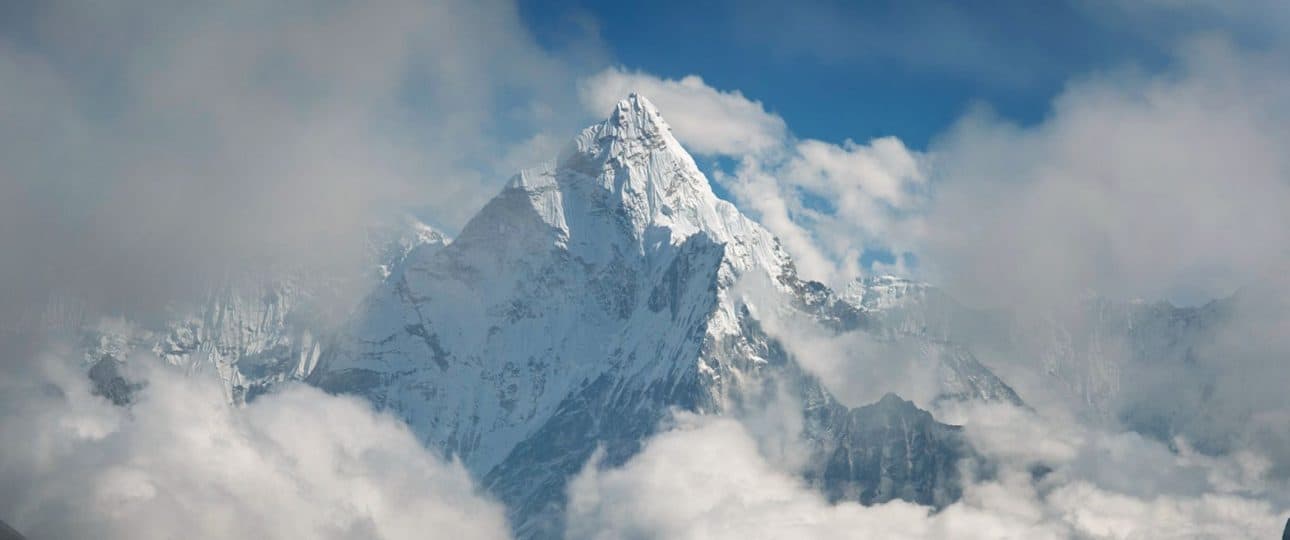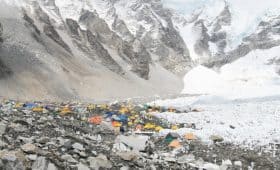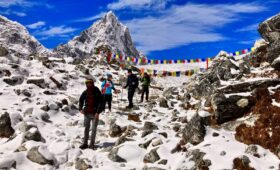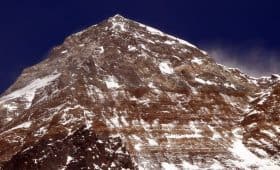Everest Base Camp Cho La Pass difficulty level depends on various factors such as the trek itinerary, walking hours, etc.
Other than above, temperatures during the trek, altitudes, etc., determine the difficulty of the Everest Base Camp Cho La Pass trek.
The trek follows the route via a high pass called the Cho La Pass at 5330m to the Everest Base Camp.
Cho La pass is physically demanding throughout the year, and if you attempt it during the winter season, you will also need special footwear.
The best time to take this trek is autumn and spring. However, if you choose to trek in other seasons, you need to prepare well.
Crossing the Chola Pass is the most challenging part of the trek, especially due to snow and strong winds.
During your Everest Base Camp trek via Chola Pass Trek, you will make your way through the Gokyo valley. You will explore turquoise lakes with awesome glacier views and Himalayan views from the top of Gokyo Ri.
Additionally, you will cross the high altitude pass of Cho La Pass.
Finally, you will step at the base camp of the top of the world along with the Kala Pattar hike with further exciting challenges.
Overall, the trek rates as an adventurous trekking route that requires a good level of physical fitness, and one should have a positive attitude towards hiking at altitude.
The various factors that determine the difficulty of the EBC Chola Pass trek are as follows:
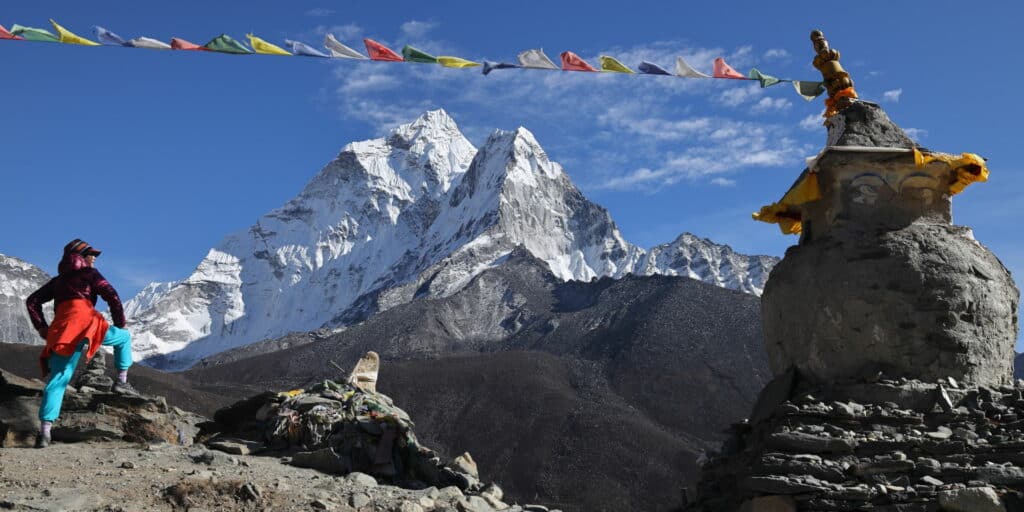
Table of Contents
- Walking Hours and Trek Duration
- Suggested Itinerary for Everest Base camp Cho La Pass Trek
- Cost of Everest Base camp Cho La Pass Trek
- Weather and Temperature During the Everest Base Camp Cho La Pass Trek
- Everest Base Camp Cho La Pass Difficulty in Different Seasons
- Altitude Sickness in Everest Base Camp Cho La Pass
- Difficulty Finding Accommodation During the Everest Base Camp Cho La Pass Trek
- Hiring Guide or Porter for Everest Base Camp Cho La Pass Trek
- Physical Training to Overcome Everest Base Camp Cho La Pass Difficulty
- Packing for EBC Cho La Pass Trek
- Tips to Avoid Difficulties for EBC Cho La Pass Trek
- Conclusion
Walking Hours and Trek Duration
The duration of the Everest Base Camp Cho La pass trek depends on the package you choose, which can range from 16 to 20 days.
Adjust the trek length for a personalized adventure.
Enjoy stunning landscapes with snow-covered Himalayan peaks, dominated by iconic Mount Everest. Conquer Cho La Pass and don’t miss Gokyo Ri and Kala Patthar for amazing views.
Choose clockwise or anticlockwise trek. For flexibility, go anticlockwise, exploring Everest Base Camp, summiting Kala Patthar, and crossing Cho La Pass. This ensures you still enjoy the trek even if Cho La Pass is closed due to snow.
It is important to train yourself before the trek by hiking for 3 or 4 hours daily. You need to focus mainly on building stamina and preparing yourself for the higher altitude.
Consider Cho La Pass difficulty, altitude, weather, and itinerary for a safe and rewarding trek. Accept the challenges, explore the heights, and create lasting memories.
Want more information? Send us your query, and our experts will get back to you within 24 hrs.
Suggested Itinerary for Everest Base camp Cho La Pass Trek
We, here at Mosaic Adventure, offer a 20 Days itinerary.
It includes 4 nights of stay in Kathmandu and 15 nights of stay on the trek.
Before the trek, there are 2 nights given for participants to rest from jet lag, explore some sights in Kathmandu and acclimatize to the city’s altitude of 1345 meters.
After the trek, there are two days kept as part of the standard program, but you can add more days as needed based on your requirements.
Day 1: Arrival in Kathmandu (1345m/4412ft) – Upon arrival, we will meet you at Tribhuwan International airport and transfer you to hotel.
Day 2: Pre-trek meeting and Kathmandu Valley sightseeing – We will have a meeting to discuss the trek details, followed by a guided tour of the historic and heritage places of Kathmandu Valley.
Day 3: Short flight to Lukla (2840m/9320ft) – Trek to Phakding (2610m/8560ft) – Approx. 3.5 hours – We will take a scenic flight to Lukla and then trek to Phakding.
- If you are trekking during the peak season, the flight to Ramechap will operate from Lukla.
- Therefore, when flying to Lukla or taking the return flight, it will be from Ramechap and you will need to drive for 4 hours each way to reach Ramechap.
- Even though there is a 4 hours drive included, it won’t affect the overall number of days of the trip.
- Mosaic Adventure organizes the transfers to Ramechap.
Day 4: Trek to Namche Bazaar (3440m/11290ft) – Approx. 6 hrs – We continue our trek to Namche Bazaar, a bustling town known as the gateway to Everest.
Day 5: Acclimatization day trip around Namche Bazaar – We will take a day to acclimatize and explore the surroundings of Namche Bazaar. Will go to higher altitude places like Syangboche.
Day 6: Trek to Tengboche (3860m/12660ft) – Approx. five hours – Our trek leads us to the picturesque village of Tengboche, known for its stunning monastery.
Day 7: Trek to Dingboche (4360m/14300ft) – Approx. 5 hrs – We continue our journey to Dingboche, surrounded by majestic Himalayan peaks.
Day 8: Acclimatization day trip around Dingboche – Another day to acclimatize and enjoy the beauty of Dingboche. Hike to Nagartsang peak to adjust your body with increasing altitude.
Day 9: Trek to Lobuche (4940m/16207ft) – Approx. 5 hrs – Our trek takes us to Lobuche, a village situated in between towering mountains.
Day 10: Trek to Everest Base Camp (5300m/17400ft) – Back to Gorak Shep (5170m/16961ft) – Today, we reach Everest Base Camp and return to Gorak Shep.
Day 11: Hike up to Kalapattar (5545m/18192ft) – Trek to Dzongla (4830m) – Approx. 8 hours – We ascend Kalapattar for sunrise views before trekking to Dzongla.
Day 12: Trek to Thangnak via Cho La Pass (5420m) – Approx. 5 hours – Another adventurous and important day of the trip as we cross the Cho La Pass and reach Thangnak.
Day 13: Trek to Gokyo – Approx. 4 hrs – Our journey continues to Gokyo, a picturesque village with stunning glacial lakes.
Day 14: Gokyo Ri (5357m) day trip – We climb Gokyo Ri for a panoramic view of the Himalayas and the Gokyo valley.
Day 15: Trek to Dole (4110m) – Approx. 4 hours – Descending from Gokyo, we reach the peacefull village of Dole.
Day 16: Trek to Namche Bazaar – Approx. 6 hours – We descend back to Namche Bazaar from where we earlier headed towards EBC visa Tyangboche.
Day 17: Trek to Lukla (2840m) – Approx. 7 hours – Our final trekking day brings us back to Lukla, where we started this journey.
Day 18: Fly back to Kathmandu – We take a short flight back to Kathmandu. Rest of the day for you to relax.
Day 19: Rest day, shopping, or leisure – A well-deserved rest day to explore Kathmandu, go shopping, book message or simply relax.
Day 20: Departure or extend your tour – It’s time to go home or extend your stay for more exciting adventures visiting other places in Nepal.
Cost of Everest Base camp Cho La Pass Trek
Currently, we are operating Everest Base Camp and Cho La Pass Trekking tour at a minimal cost of USD 1630 per person.
You can book this trek through us for any date throughout the year.
However, please note that the minimum number of participants required to run the tour is 2 people.
For more details on the cost and other aspects of the Everest Base Camp and Gokyo Lakes trek, you should browse our trip page.
If you have any questions regarding the departure date, cost, or if you are interested in a customized trip, please reach out to us immediately for great assistance from one of the Mosaic Adventure team members.
Weather and Temperature During the Everest Base Camp Cho La Pass Trek
The weather plays a huge role in determining the difficulty of the Everest Base Camp Cho la pass trek.
One of the most unpredictable elements of this trek is the weather, and you might find yourself in an uncomfortable situation.
Therefore, you need to prepare well for the twists, turns, and fluctuations of weather conditions that can occur during the trek.
Generally speaking, nights are much colder than daytime hours.
Although there is no way to know exactly what each day in the mountains will bring, the weather and temperature tend to be somewhat predictable depending on the season.
Everest Base Camp Cho La Pass Difficulty in Different Seasons
Taking the Everest Base Camp Cho la pass trek is most difficult during winter. Due to heavy snowfall, crossing the Cho La pass becomes almost impossible.
In fact, the pass remains closed due to various risk factors. The temperature drops easily to -20 degrees Celsius during the night and early morning.
Spring happens to be one of the best times to take this trek. During springtime, the maximum temperature is 25 degrees Celsius during sunny days, and the minimum temperature is -15 degrees Celsius in the morning and at night.
This is a suitable temperature for trekking, making your treks a lot less difficult. During this time, you will witness the view of clear blue skies and many different species of flowers in the lower altitude.
Also, due to the peak season, there are many trekkers on the trails.
Summer from June to August coincides with the monsoon season. Hence it is not the best time for Everest Base Camp Trek in August or similar monsoon months due to rain at lower altitudes.
The trail is difficult and risky due to slippery and muddy trails.
Even in areas above 4000 meters, it rains sometimes, and although it is also sometimes dry, the maximum temperature during this time averages 25 degrees Celsius during sunny days, with a minimum of -15 degrees Celsius in the morning and at night.
Autumn is also a good season to take the Everest Base Camp Cho La pass trek. While it lacks the beauty of flowers, you will get a view of clear blue skies with incredible mountain views.
The maximum temperature during this time is 20 degrees Celsius during sunny days, with a minimum of -10 degrees Celsius in the morning and at night.
Hence, planning your trek during Spring and Autumn can reduce the trek difficulty caused by weather.
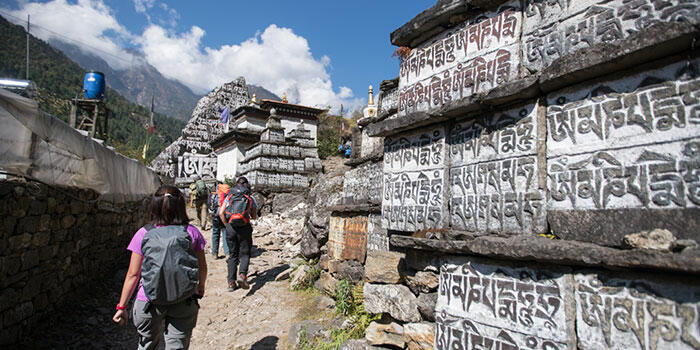
Altitude Sickness in Everest Base Camp Cho La Pass
One of the major factors at play while trekking in the mountains is altitude. Acute mountain sickness (AMS) is ever-present at high altitudes.
The Everest Base Camp Cho La Pass trek is an adventurous trek due to its great variation. Thus, one of the major difficulties during the trek is adjusting to high altitude.
The trek starts at a lower altitude of 2652m in Phakding and reaches a higher altitude of 5545m at Kala Patthar. During this trek, you will cross above 5000m multiple times, increasing your risk of altitude sickness.
Everyone is at risk of altitude sickness.
It is, therefore, essential to educate yourself about altitude sickness to ease your trekking difficulty.
Resting and acclimatization are critical to adjusting to higher altitudes.
It is never a good idea to speed up your trek or continue trekking while experiencing symptoms of AMS. Doing so can worsen your health and lead to a more severe condition.
If you find yourself experiencing symptoms of AMS, and resting doesn’t help, then descending is the only option.
Walking slowly, taking regular breaks, and drinking plenty of water are some ways to help you stay away from altitude sickness.
Also, say no to alcohol while trekking as it boosts the risk of altitude sickness. Always seek help from the guide if you experience any symptoms of AMS.
This way, you can take the necessary precautions to overcome it before it becomes life-threatening.
Difficulty Finding Accommodation During the Everest Base Camp Cho La Pass Trek
The Everest Cho La Pass trek has numerous lodges that provide meals and accommodation. The lodges provide rooms with blankets.
However, it is important to carry your own sleeping bag for the cold nights and mornings.
These lodges have small rooms that provide a basic lodging experience during your trek. The lodges offer standard rooms.
If you are seeking luxury accommodation, then you can consider Everest Luxury trekking. This involves luxury accommodation throughout the whole trek.
Hiring Guide or Porter for Everest Base Camp Cho La Pass Trek
The Everest Base Camp Cho la pass trek is a long duration trek that requires an experienced guide and a porter.
Trekking into the mountains can be tricky, and having a guide provides you with the safety of not getting lost.
Since these guides are often on the trails, they know what to expect and are able to take necessary precautions in times of crisis.
Additionally, a guide will provide you with better experience by informing you about all the necessary knowledge regarding the places you will pass by.
Now, having a porter is equally important because the Everest Cho la pass trek is a challenging trek.
With a porter, you will not have to worry about carrying a heavy burden, which makes your trekking experience a lot easier.
This way, you can focus on your own safety and enjoy walking freely. The cost of hiring a guide or porter is almost the same, except for a couple of dollars.
It ranges from 25-40 USD per day.
Physical Training to Overcome Everest Base Camp Cho La Pass Difficulty
Chola Pass Trekking is one of the difficult treks of its category. Many trekkers take this trek during the main seasons of spring and autumn.
While many succeed in completing the trek with little or no pain, there are also many who fail.
During this trek, you will spend most of your days above 3500m. High altitude can make it difficult to breathe in some cases, which is the main reason for the trek being difficult.
For a trekker with experience in high altitude, the trek will be of easy to moderate level. But if you are new to trekking, we recommend that you have some training at home.
You can practice walking around the hills that might be available around your place.
Training will make your trek a lot easier compared to the ones coming without any training. Since the Chola Pass Trekking is demanding, it is important to prepare your mind accordingly.
The route is mostly uphill climbing towards Gokyo and Everest Base Camp and mostly descending while returning back to Namche and Lukla.
For people with knee problems, it is important to bring proper knee support; otherwise, you may suffer a lot. Nothing can guarantee your success in this extreme altitude except the slow and steady walk.
You can prepare with regular cardiovascular training at home, such as cycling, swimming, and lots of walking. Seek out hills or find a tall building and walk up and down the stairs repeatedly.
It may help you a lot during the trek.

Packing for EBC Cho La Pass Trek
Packing wisely plays an important role in making your trip smooth, convenient, or less difficult, which can vary according to the season in which you choose to trek.
Therefore, before you pack, it is wise to check the climatic conditions, weather, and temperature of the region.
Additionally, we recommend that you pack no more than 20 kg, whether you choose to carry your own luggage or hire a porter.
Packing wisely can make your trips a lot more comfortable.
To take the EBC Cho La Pass trek, you need a good and comfortable pair of trekking boots, as well as trekking poles, crampons, a sleeping bag, a sturdy backpack, a personal first-aid kit, toiletries, and insect repellent for the monsoon season.
However, regardless of the season, we advise you to dress in layers because this trek has great variation in temperature as you ascend or descend.
Dressing in layers allows you to adjust according to the situation. Be sure to choose moisture-wicking material for the base layers of your clothing.
Tips to Avoid Difficulties for EBC Cho La Pass Trek
- Check the weather and temperature and pack accordingly
- Choose peak season for moderate weather with lesser difficulty.
- Pre-book for the accommodation during peak season to get the desired room without compromising on facilities.
- Always stay hydrated by carrying water bottles and water purifiers.
- Maintain your own pace and avoid rushing.
- For a peaceful trekking experience, opt for the off-season.
- Keep buffer days in case of any delays or unplanned situation.
Conclusion
The Everest Base Camp Chola Pass Trek is an absolute adventure into the Everest region.
It is a challenging trek, but with a little bit of preparation and choosing the right time, you can overcome the difficulties of the Everest Base Camp Cho La Pass.
Taking this trek will allow you to discover your inner strength and capabilities.
Moreover, there is no doubt that this trek will provide you with an experience of a lifetime.
For further questions and queries, please feel free to contact us. We are happy to guide and assist you to the best of our knowledge.
Want more information? Send us your query, and our experts will get back to you within 24 hrs.
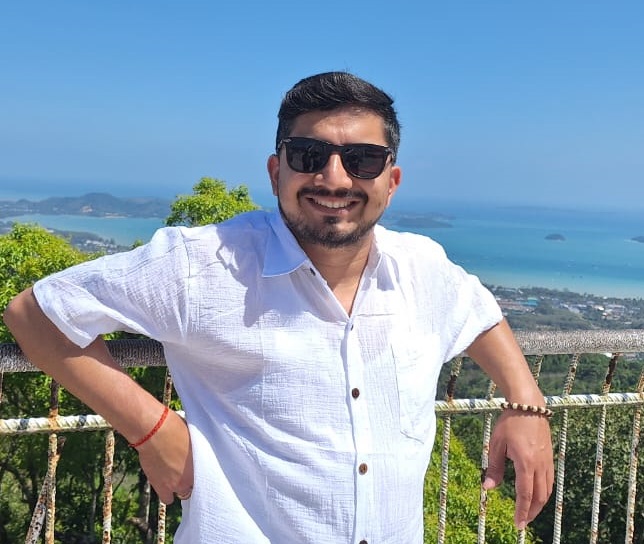
Madhav started working as a porter in 2001 and then moved on to work as a trekking guide. After working in the trekking and tourism industry for eight years, he co-founded Mosaic Adventure in 2009.
Madhav has trekked to most of the trekking destinations in Nepal, including Everest Base Camp Trek, Annapurna Base Camp, Annapurna Circuit Trek, Poon Hill Trek, Jomsom Muktinath Trek, Indigenous Peoples Trek, Langtang Valley Trek, Mardi Himal Trek, and all of the day hikes around Kathmandu.
He has also extensively traveled to other countries such as Australia, the USA, the UK, France, Hong Kong, Japan, China, the Philippines, the UAE, Saudi Arabia, Bahrain, Thailand, Turkey, and India. Madhav is the one who answers most of your questions about trekking and tours and helps to plan your trip by giving a personal touch.

